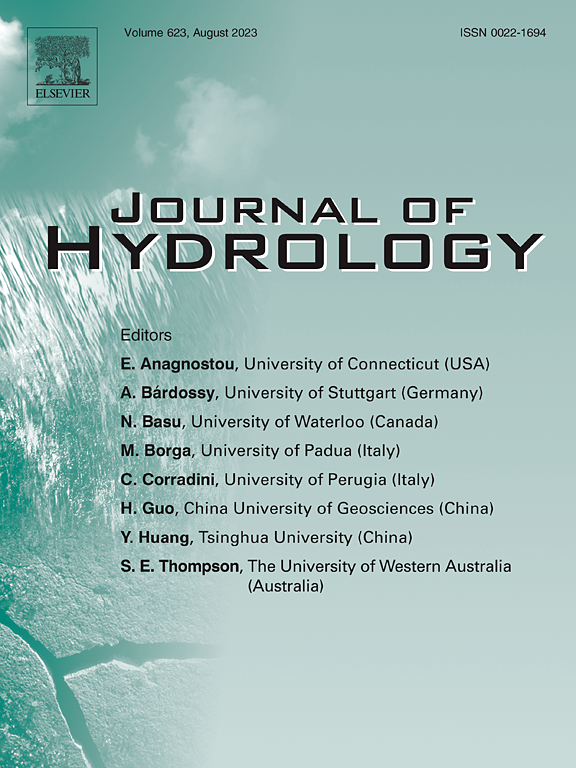Dynamic soil water stress function improves evapotranspiration estimation in areas with significant vegetation variability
IF 6.3
1区 地球科学
Q1 ENGINEERING, CIVIL
引用次数: 0
Abstract
Accurate estimation of evapotranspiration (ET) is crucial for understanding water and carbon cycles, and water resource management. Direct ET measurements are expensive and technically challenging. A common indirect estimation method involves multiplying potential evapotranspiration (PET) by a soil water stress function (β). However, a soil water stress function with static parameters (βS) was generally used in models, neglecting the variation in soil moisture availability under different atmospheric and vegetation conditions. Additionally, although various linear and nonlinear forms of β have been developed, comparisons of their performance in ET estimation using large observational datasets remain limited. In this study, we evaluate ET estimation using three widely used forms of β (linear, exponential and sigmoid) across 135 global eddy covariance sites, and propose a soil water stress function with dynamic parameters (βD), which adjusts β based on variations in atmospheric demand (PET) and vegetation conditions (leaf area index, LAI). Subsequently, we compare the ET estimates from βS and βD with observed ET. Results show that the performance of ET estimation using the exponential function outperforms the linear and sigmoid functions, with mean NSE values of 0.38, 0.25, and 0.34, respectively. Furthermore, the βD method (mean NSE = 0.58) significantly improves ET estimation accuracy compared to the βS method (mean NSE = 0.33), particularly for vegetation types such as MF and DBF. Vegetation is the key determinant of the difference between βD and βS. Specifically, the βS method tends to overestimate ET at low intensities and underestimate ET at high intensities, especially in regions with high vegetation variability. Our findings underscore the importance of incorporating dynamic characteristics of β, particularly in areas with significant vegetation changes.
动态土壤水分胁迫函数改善了植被变异性显著地区的蒸散发估算
准确估算蒸散发(ET)对于理解水和碳循环以及水资源管理至关重要。直接蒸散发测量既昂贵又具有技术挑战性。一种常用的间接估算方法是将潜在蒸散发(PET)乘以土壤水分胁迫函数(β)。然而,模型一般采用静态参数(βS)的土壤水分胁迫函数,忽略了不同大气和植被条件下土壤水分有效性的变化。此外,尽管已经开发了各种线性和非线性形式的β,但它们在使用大型观测数据集估算ET方面的性能比较仍然有限。在这项研究中,我们利用全球135个涡动相关点的三种广泛使用的β(线性、指数和s形)形式来评估ET估算,并提出了一个具有动态参数的土壤水分胁迫函数(β d),该函数根据大气需要量(PET)和植被条件(叶面积指数,LAI)的变化来调整β。随后,我们将βS和βD的ET估计与观测ET进行了比较。结果表明,使用指数函数估计ET的性能优于线性和s型函数,平均NSE值分别为0.38,0.25和0.34。此外,βD方法(平均NSE = 0.58)比βS方法(平均NSE = 0.33)显著提高了ET的估计精度,特别是对于MF和DBF等植被类型。植被是决定βD和βS差异的关键因素。具体而言,βS方法在低强度下容易高估ET,在高强度下容易低估ET,特别是在高植被变异性地区。我们的发现强调了纳入β动态特征的重要性,特别是在植被变化显著的地区。
本文章由计算机程序翻译,如有差异,请以英文原文为准。
求助全文
约1分钟内获得全文
求助全文
来源期刊

Journal of Hydrology
地学-地球科学综合
CiteScore
11.00
自引率
12.50%
发文量
1309
审稿时长
7.5 months
期刊介绍:
The Journal of Hydrology publishes original research papers and comprehensive reviews in all the subfields of the hydrological sciences including water based management and policy issues that impact on economics and society. These comprise, but are not limited to the physical, chemical, biogeochemical, stochastic and systems aspects of surface and groundwater hydrology, hydrometeorology and hydrogeology. Relevant topics incorporating the insights and methodologies of disciplines such as climatology, water resource systems, hydraulics, agrohydrology, geomorphology, soil science, instrumentation and remote sensing, civil and environmental engineering are included. Social science perspectives on hydrological problems such as resource and ecological economics, environmental sociology, psychology and behavioural science, management and policy analysis are also invited. Multi-and interdisciplinary analyses of hydrological problems are within scope. The science published in the Journal of Hydrology is relevant to catchment scales rather than exclusively to a local scale or site.
 求助内容:
求助内容: 应助结果提醒方式:
应助结果提醒方式:


